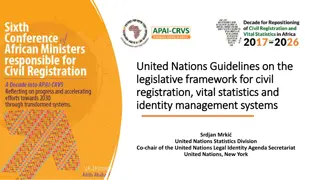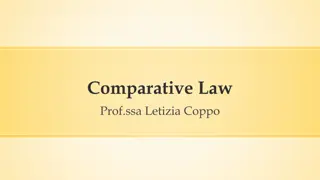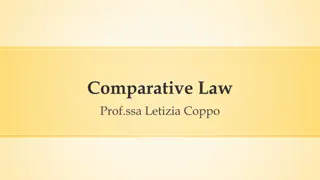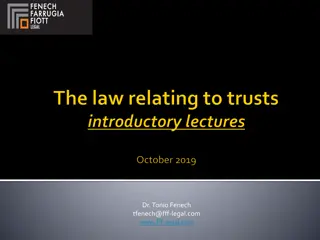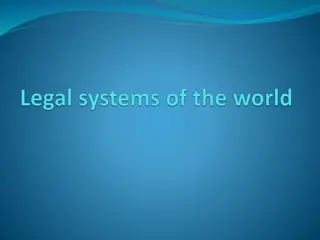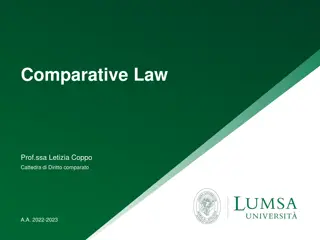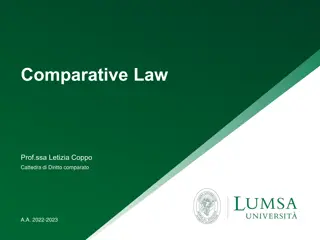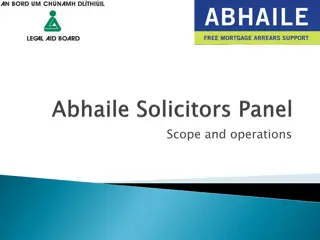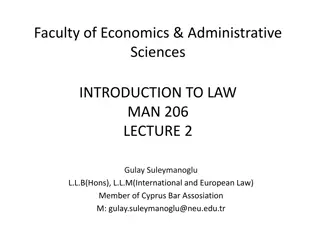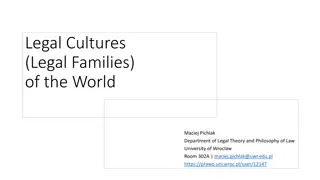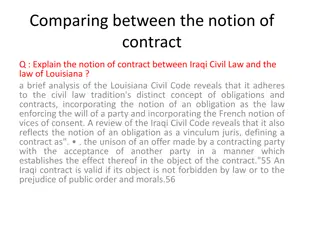Comparative Analysis of Civil Law vs. Common Law Traditions in Western Legal Systems
The study delves into the historical and philosophical foundations of Civil Law and Common Law traditions within the Western Legal framework, examining their divergences and convergences. It highlights the influence of historical backgrounds, legal systems' organization, and the impact of constitutional principles on legal development in both traditions.
Download Presentation

Please find below an Image/Link to download the presentation.
The content on the website is provided AS IS for your information and personal use only. It may not be sold, licensed, or shared on other websites without obtaining consent from the author. Download presentation by click this link. If you encounter any issues during the download, it is possible that the publisher has removed the file from their server.
E N D
Presentation Transcript
Comparative Law Prof.ssa Letizia Coppo
THE WESTERN LEGAL TRADITION CIVIL LAW v. COMMON LAW Civil law: the expression comes from jus civile and refers to all those experiences that from a historical viewpoint have their roots in Medieval continental Europe. [see annex] Common law: the expression comes from jus commune and refers to all those experiences that have their roots in Medieval and modern English law.
CIVIL LAW v. COMMON LAW Legal tradition: according to John Merryman (*) it is a set of deeply rooted, historically conditioned attitudes about the nature of law, about the role of law in the society and the polity, about the proper organization and operation of the legal system, and about the way law is or should be made, applied, studied, perfected, and taught . (*) J. MERRYMAN, The Civil Law Tradition: An Introduction to the Legal Systems of Western Europe and Latin America, 1985.
CIVIL LAW v. COMMON LAW Historical remarks on the major divergences In the age of the great codifications the opposition between civil law and common law was grounded on the presence or absence of codified law. At the beginning of the XX century the difference was said to be that civil law countries were based on written law, while common law countries on unwritten customary law. Another difference was that in Common law countries judgments are a source of law.
CIVIL LAW v. COMMON LAW Historical remarks on the major convergences Constitutionalisation of the system: both in common law and civil law constitutional legality prevails over legislation and political power. Spread of French revolution values in both systems: democratic representation, laicit , solidarity or fraternity, equality and liberty. Renewed interest in mixed systems, as they cast light on the strengths and weaknesses of the two traditions.
THE CONCEPT OF WESTERN LEGAL TRADITION The comparison between civil law and common law reveals: 1. a shared political and cultural background 2. a different legal and technical background 3. shared contemporary problems and challenges A proper reconstruction of the historical background is crucial to understand the reasons underlying such convergences and divergences.
THE CONCEPT OF WESTERN LEGAL TRADITION Historical background: two crucial stages for the development of the Western Legal Tradition Medieval common background: creation of a wide area of jus commune, as all the different political organisations on the European territory evolved through identical organisational and procedural schemes. Gregorian reform: sub-product of the great effort to rebuild the Roman Catholic Church.
THE CONCEPT OF WESTERN LEGAL TRADITION Features of the Medieval common background: Fusion of heterogeneous components coming both from the late Roman law and from the Germanic tradition. Creation of open systems which were a mixture of sources with different origins and nature: ecclesiastical, lay, royal and customary. The fracture came with the spread of the scientia juris , with its ordering categories (see below).
FEATURES OF THE WESTERN LEGAL TRADITION 1) Law is conceived as something autonomous from religion and politics: those latter can and do have an impact on law, but they are not identified with it. 2) Law is committed to professionals provided with specific skills and background, a specific linguistic and conceptual apparatus and a specific literature. And such technical background becomes an organisational formant of the system: legal institutions can be perceived only through the mentioned apparatus of concepts.
FEATURES OF THE WESTERN LEGAL TRADITION 3) Law is conceived as a coherent system, i.e. an integrated and autopoietic system, capable of developing through time as it includes tools for self-regulation and adaptation to external changes of circumstances. 2 keywords: vitality of the system legitimacy of the system
FEATURES OF THE WESTERN LEGAL TRADITION 1. Vitality of the system: it depends upon the necessity to ensure coordination among the plurality of orderings that live together and compete within the same community. 2. Legitimacy of the system: it is based on the fact that the system identifies itself with the superior concept of order. < Western conception of the world as an ordered set of phenomena; law is the order of human relationships that mirrors the order of things.
FEATURES OF THE WESTERN LEGAL TRADITION 4) Assumption that the single rules are intelligible only when located in the context of conceptually ordered procedures and institutions. 5) Assumption that legality prevails over sovereignty, i.e. political power is not allowed to take over the legal ordering, which provides itself the appropriate procedures for the legitimate expression of political will. This latter way of thinking developed in Europe during the XI century and involves the never ending issue of the relationship between law, justice, politics, morals and religion.
RELEVANT CHRONOLOGICAL STEPS OF THE WESTERN LEGAL TRADITION 1) Formation or formative stage (around XII and XIV century) 2) The age of consolidation (from XIV to XVIII century) 3) The age of revolutions (from the 2nd half of XVIII century to the 1st world war) 4) Contemporary age (from 1930 to nowadays)
Comparative Law Prof.ssa Letizia Coppo
THE COMMON ROOTS OF THE CIVIL LAW TRADITION Common law: it developed from political power, from the administration of Normans and Plantagenets; it developed in the courts established by them. Civil law: it developed from the gaps of the political system; it has risen in a time when Europe was culturally but not politically united, as, despite the efforts, the Church and the Emperor failed to rebuild a Roman Empire. Civil law developed in the universities.
THE UNIVERSITIES AND THE DAWN OF SCIENTIA JURIS Underlying needs: wide-spread need for order; social need to regulate human relationships with pre-determined procedures and rules rather than through the use of force. - Universities showed that it was possible to apply the set of rules coming from late Roman law even to the current conflict of interests raised by human relationships. - They could teach the ability to think in terms of institutional problems, conceive issues that had not been classified before in terms of logical mental ordering. Legal education become crucial.
THE UNIVERSITIES AND THE DAWN OF SCIENTIA JURIS Legitimacy concerns: at that time Europe lacked unity and a centralised power, so nobody could establish a judicial system entitled to issue decisions and enforce them. Then, why should people comply with certain rules if such rules are not enforceable? Do people follow rules just because they are imposed to them? What does provide legal rules with legitimacy? The answer are authority and persuasion (think of Irnerio s nickname, lucerna juris). Those two are crucial also nowadays, as they are the source of legitimacy for soft-law.
THE UNIVERSITIES AND THE DAWN OF SCIENTIA JURIS The concept jus dicere: it does not mean finding rules on the basis of wisdom and experience, but interpreting a text provided with its own authority. Key-skill: interpretation based on the intellectual and logical tools drawn by Medieval philosophy (which had been practiced a lot in the interpretation of the Bible). Authority of the Corpus juris: its legitimacy was weaker than the one of the Bible, but the Corpus was presented as a promising and useful set of rules capable of meeting the thirst for a renovatio.
THE UNIVERSITIES AND THE DAWN OF SCIENTIA JURIS Features of the Corpus juris: it encompassed Roman law as a whole, so it reflected a complete and exhaustive system (designed for a far more complex society than the Medieval one) with basically no gaps to be filled in (whereas common law systems were originally incomplete). It became a meta-model , a-historical and therefore typically universal: for this reason and for the need of adapting it to modern problems, literal interpretation could not be the paramount hermeneutic criterion.
THE UNIVERSITIES AND THE DAWN OF SCIENTIA JURIS Consequences of the completeness of the system Jurists facing gap-less systems develop skills other than the ones needed by jurists facing complete systems. They do not need to find from time to time the best solutions, but they need to get a grasp of the whole system, to organise their mentality in a systematic way. They need a different interpretative tool box: glossae, summae, definitiones, distinctiones, quaestiones.
LEGACIES OF THIS WAY OF THINKING 1) Distinction between formal structure and substantive content of decisions Common law conceives judgments as turning into law what was not law; bending reality towards the law; judgments create law. Civil law judgments are conceived as a subsumption process, the fulfilment of the logical reasoning that is already contained in general provisions or in the principles on which the system is grounded; judgments do not create law, but apply the law.
WARNINGS Interpretation was not reduced to mere syllogism: interpretation was not reduced to a if x, then y logic, but was based on a plurality of criteria and also carried value-based judgements inspired by the idea of justice. Law is a science, but its reference is society, i.e. a magmatic, non scientific concept, in constant evolution. Dichotomy: there was thus a continuous dichotomy between theory and practice, the announced methodology and the interpretative technique applied for solving the case.
THE INFLUENCE OF CHURCH AND CANON LAW Gregorian Reform: it provided the model of a complex organisation grounded on legal rules and procedures, with its ecclesiastical hierarchies, division of powers between the Pope and the bishops, legal status of the clergy, liturgical and administrative apparatus Restatement of Canon law by Graziano: it spread quickly, as church were present everywhere, and opened the way to the reception of jus civile. It played a significant role in the formation of jus commune.
THE INFLUENCE OF THE CHURCH AND CANON LAW Main legacies of canon law Defects of consent (very refined in the canon law rules on marriage) Good faith Prohibition of usury Ideals linked with Catholic morals Civil and criminal procedure rules: struggle for a legally based trial grounded on strict and predetermined legal rules.
THE FORMATION OF JUS COMMUNE Historical background: XIV-XVIII century Roman common law as taught in the Universities and applied in courts spread all over Europe and was maintained as a basically unitary tradition. All the different areas of Europe were also governed by local customs and statutes, but the great ordering categories provided by jus commune transformed original ideas siding them with a complex net of classification concepts.
JUSNATURALISM and JUSRATIONALISM Jusnaturalism: a cosmopolitan ideal stream aimed at finding the ethical basis of legal rules. Historical background: XVII-XVII century; another cultural stream that integrated scientia juris, spread all over Europe and had a strong impact in particular in England and in the US. Features: with jusnaturalism the European conscience was oriented towards a system in which law was conceived in the context of moral philosophy
JUSNATURALISM and JUSRATIONALISM Jusrationalism: an ideal stream developed by Ugo Grozio, according to which legal rules are linked to the acknowledgement of the rationality inherent in human beings. Human beings have a natural inclination towards the organisation of their social relationships and that is what encourages them to get out of the state of nature. Legacy: systematic study of the rules as a guarantee of their rational legitimacy; identification of the problems behind the single cases and identification of the rational basis of rules to assess them critically.
JUSNATURALISM and JUSRATIONALISM General context The Corpus juris is gradually loosing its authority and prestige due to new ideals and political theories (Macchiavelli, Hobbes, Bodin ): need to rebuild the universal category of justice on the basis of shared ethics rather than of a commonly recognised authority. Christianity is gradually loosing its unity due to the Reform and the Counter-Reform: no more common unitary Christian ethics.
THE CRISIS OF JUS COMMUNE In continental Europe jurists remained basically faithful to the authority of their legal tradition and sceptical to the critical way of thinking upheld by jusnaturalist and jusrationalists. Such streams did have prominent supporters also in continental Europe (Domat, Pothier, Leibniz ), but were not as successful as in England (see Backstone below). Double crisis: legitimacy and function.
THE CRISIS OF JUS COMMUNE Reasons of the crisis Crisis of the justice system in consequence of the reforms committed by European sovereigns to jurists in order to centralise administration and weaken the power of feudal lords. Time after time such jurists have become independent from the sovereign and opponents to the central power. Criminal law, instead, remained subject to political power, but the weakness of this latter led judges to the adoption of radical positions, strictly based on tradition and closed to critical thinking.
THE RISE OF THE LEGISLATIVE IDEOLOGY In such context of wide-spread crisis new ideologies developed in a renewed cultural environment. Key-words: reason; enlightment. It is the period of Encyclopaedia, Illuminismo, technical revolution: need for reforms, for rationality, for the predictability and certainty of law. Main consequences Judges are seen as bouche de la loi (mechanical law applicators) Movements towards the codification of law.


